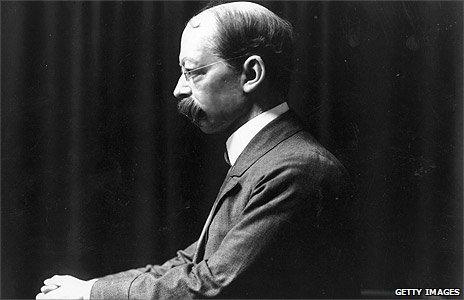Was Dr Crippen innocent of his wife's murder?
- Published

Hawley Crippen, the doctor hanged for the gruesome murder of his wife Cora, is one of the most infamous killers in British history. Exactly 100 years after his arrest, why is there a campaign to prove his innocence, asks Stephen Tomkins?
Having the surname Crippen does not endear you to UK Customs, according to a distant relative of the infamous doctor convicted of killing his wife.
James Patrick Crippen of Ohio, second cousin three times removed of Dr Hawley Crippen, hopes to officially exonerate the black sheep of the family and bring his remains to the family plot in Michigan for a decent burial.
"The evidence says the man should be pardoned," he says. "But everyone thinks of him as a murderer. Every time I have come through customs to England, someone has made a comment on my name, linking me to a murderer."
Crippen rose to infamy by allegedly poisoning and dismembering his wife, hiding her remains under the basement floor, and fleeing for North America with his lover - and then being the first person to be caught using the wireless telegraph.
The message was sent 100 years ago, and Crippen was arrested on arrival in Quebec on 31 July, 1910. His trial lasted only five days, and the jury's deliberations for less than half an hour.
The torso was identified as Cora Crippen's by a scar, the doctor was shown to have bought a large amount of the drug that killed her, and on his arrest he told Chief Inspector Dew: "I am not sorry; the anxiety has been too much."
The mild-mannered murderer became a national celebrity and his waxwork stands in Madame Tussauds to this day. But was it all a huge miscarriage of justice? Was Crippen innocent after all? A growing body of people believe so, including family members and forensic scientists, and a campaign is under way to clear his name.
One line of evidence comes from John Trestrail, a toxicologist who has long puzzled over the mutilation of the corpse. The remains found were a torso without bones or sex organs.
Mutilation is extremely unusual behaviour among poisoners, Mr Trestrail says. "A poisoner wants the death to appear natural so he can get a death certificate. This is the only case I know of where the victim was dismembered. It doesn't make sense."
'He finally cracked'
Mr Trestrail brought in Professor David Foran, director of forensic science at Michigan State University, who led DNA analysis on the scarred skin of the corpse used in the trial. It was demanding work over two years, retrieving tissue preserved in formaldehyde from the glass slide it was attached to with pine resin.
Crippen's house in north London has since been demolished
Mr Foran followed two lines of research and considers the results conclusive. First he isolated mitochondrial DNA, which remains unchanged throughout the generations down the female line. A genealogist found grandnieces of Cora Crippen who would have the same mitochondrial DNA as her, and repeated tests found they were not related to the body in the basement.
Then Mr Foran's team used new techniques to examine the nuclear DNA, and discovered a Y chromosome. Not only was the body not from Cora Crippen's family, it wasn't even a woman.
As Mr Trestrail sums it up, "This is the slide which Spilsbury [the expert witness at the trial] used to identify the body as Cora Crippen's. And this was the evidence on which Crippen was convicted. But the substance in the slide is not Cora Crippen. No question. I don't say Hawley Crippen is innocent, but he is no longer proven guilty."
Not everyone is convinced, however. John Boyne, whose book Crippen: A Novel of Murder, is to be reissued next year, says: "I think Crippen probably did kill his wife. His actions suggest guilt - his decision to flee the country and to dress Ethel LeNeve as his son rather than allow her to reveal her true identity on the ship as his lover. Cora made his life so miserable that I think he finally cracked."
Jonathan Menges, a writer and genealogist from San Diego, has written disputing Mr Foran's findings. Mr Menges claims the genealogy linking the living relatives to Cora Crippen is flawed - no birth certificate for her exists, for example, as they were rare in the US at the time - making the mitochondrial DNA tests irrelevant.
He criticises the proceedings for having too much of an eye for showbiz - the nuclear DNA findings were first revealed on a TV documentary - and points out that they have not yet been published or peer-reviewed. He says that Crippen's behaviour demonstrates his guilt, and that a group in Salt Lake City are investigating the mysterious disappearance there of Crippen's first wife. "There is no doubt that Crippen is guilty," he says.
Mr Foran responds that his work is to be published in the Journal of Forensic Sciences, that he is fully satisfied by the genealogy, and that the remains are indisputably male.
"I don't really care one way or the other whether the body was Cora Crippen's, I have no interest in clearing Crippen's name. What I care about is being right. We tested and tested and tested, and if I had any doubts whatsoever I would never have come out with it. The body is not Cora Crippen's."
Nevertheless, JP Crippen has failed to get the case reopened. The Criminal Cases Review Commission declined to refer it to the Court of Appeal, because he is too distant a relative to have sufficient interest.
But Mr Trestrail agrees with him that the campaign to clear his name should continue.
"It matters," he says. "Justice doesn't have a time limit."